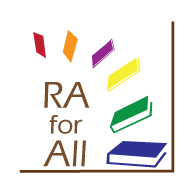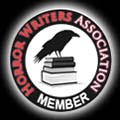 Library Journal contacted me to participate in their May 1, 2017 print cover story about how to help genre readers. I wrote about the entire series on the main blog here. They cover many genres and each article is 100% worth your time.
Library Journal contacted me to participate in their May 1, 2017 print cover story about how to help genre readers. I wrote about the entire series on the main blog here. They cover many genres and each article is 100% worth your time.But of course, they wanted me to address those of you out there who are a bit afraid of helping horror readers.
I think it is fitting that they released this series a few days early because today, I will be speaking at Librarians' Day at StokerCon 2017. Usually, I am helping library workers like the ones I am addressing in the article below-- those of you who are afraid of horror. But today, I am anticipating being among my fellow horror loving librarians.
While this will be a huge change for me, I do not think they are ready for what I am going to tell them, and that is this: It is actually much harder to help readers when you are a fan of a genre yourself.
I’ll let you know how it goes, but in the meantime, all of you horror newbies out there should rest easy. I’ve got you covered. Here is the direct link to the article, but also, since this blog is used as a reference source, I don't want a future broken link to get in the way of this article helping you to help readers, so below, you can also find the full text.
************************************************
Making Horror Less Scary | Readers’ Advisory
BY ON APRIL 25, 2017
Welcome to the world of horror fiction, where monsters roam the streets, vampires attack at night, ghosts haunt every home, and mayhem is the norm. For many library workers, just the idea of helping a horror reader, let alone reading a horror novel, is a frightening proposition. Yet you can’t hide under the covers every time someone asks for a tale of terror. Readers of all persuasions are picking up scary books in mass quantities, enough to have multiple authors other than Stephen King regularly hit the best sellers lists.
It’s time to brush up your skills and step over to the dark side. But where to begin? The hardest thing for non-horror-loving library folk to understand is that horror readers want to be scared. More than any other type of literature, the horror novel’s ultimate objective is to scare by manipulating the reader’s emotions. It gives a voice to our fears, delivering feelings of panic, chaos, destruction, aversion, and disgust that we horror readers find uncompromisingly intriguing.
Your next step is to educate yourself as to how today’s horror novels elicit these bleak sentiments, moving from the page into the minds of readers. The best horror novels create an uneasy atmosphere that follows the reader off the page. This intense sense of dread starts immediately—something is slightly anxious or gloomy as these novels open. The story might pull back after the first few pages and try to mollify the reader for a few minutes, lure them back from the edge, but that sinister edge is still there, lurking in the background. This also directly affects pacing. While there is no standard pacing to a horror novel, the one constant is that as the anxiety and terror steadily build throughout so, too, does the pace. By the end, it becomes relentless, and readers can’t stop turning the pages to see what will happen.
Horror readers also want characters about which they can care. If we don’t like the protagonist, we will not care that he or she is being chased or stalked by an evil force. The main characters need to be relatable and sympathetic. That being said, we also can’t have only relentlessly building dread and constant horrific things happening to our main characters. That is why horror generally features flashbacks—both to serve as a break in the hopelessness of the current story line and to help underscore the grim tone by going back to a time when things were happier.

BEYOND THE BEST SELLERS
That’s a quick primer on how the best horror novels ply their trade, but who are the authors you should be reading and or handing out to patrons? I assume you already know about King, Dean Koontz, F. Paul Wilson, and Peter Straub. In fact, I hope you have those authors on your automatic buy lists, but if you want to help more horror readers, here are authors whom you should also be adding to your collections and actively suggesting to patrons who want to feel the fear: Joe Hill, Jonathan Maberry, Christopher Golden, and Brian Keene. You’d be wise as well to recommend Stephen Graham Jones, Nick Cutter, Mary SanGiovanni, Ania Ahlborn, Kaaron Warren, Tananarive Due, and Victor LaValle, all of whom provide well-crafted tales of terror.
Here are five newer “sure bet” single titles that have proven appeal to a wide range of horror fans, from hard-core genre readers to patrons just looking for a good fright: Josh Malerman’s Bird Box, Sarah Pinborough’s Behind Her Eyes, Thomas Olde Heuvelt’s HEX, Jonathan Janz’s Children of the Dark, and Paul Tremblay’s Disappearance at Devil’s Rock.
FURTHER READING
Now that you have some key authors and titles in your arsenal, check out some additional resources to help you stay current and find even more great suggestions. My own book, The Readers’ Advisory Guide to Horror, 2d edition, and its online home, RA for All: Horror (raforallhorror.blogspot.com) are filled with hundreds of lists, reviews, resources, and more. Twice a year (in the October 1 and April 15 issues), I take over Neal Wyatt’s long-running Reader’s Shelf column here in LJ, providing comprehensive, library-specific horror information for adult readers.
Any story collection edited by Ellen Datlow, who is universally considered the best horror editor, is worth your time. I use her collections to identify new authors of note.
The Horror Writers Association has an entire page of resources for libraries (horror.org/libraries), which includes a member-created reading list and easy access to current and past lists of Bram Stoker Award winners and nominees.
For more regular horror and dark fiction reviews of titles that are a good fit for collections, try LitReactor (litreactor.com/tags/bookshots) and This Is Horror (www.thisishorror.co.uk/category/reviews).
Now get out there, and use this road map to chart your own path down the not-so-scary road of assisting horror readers. Maybe you will even be brave enough to try one for yourself.




No comments:
Post a Comment